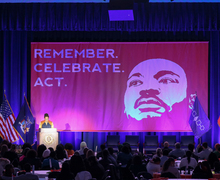Hendricks Chapel hosts vigil to promote peace during Israel-Hamas war
Maxine Brackbill | Photo Editor
Speakers shared prayers from their respective religions, inviting attendees to participate or listen in a way that honored their own beliefs.
Get the latest Syracuse news delivered right to your inbox.
Subscribe to our newsletter here.
Hendricks Chapel hosted an interfaith vigil for world peace on Wednesday evening. Members of the university and local religious communities gathered to promote peace in the midst of the Israel-Hamas war through spoken and sung prayer.
Around 50 students, faculty and staff from Hendricks’ 25 religious and spiritual life groups met on the steps of the chapel to reflect. Rev. Brian Konkol, the dean of Hendricks and professor of practice at SU, opened and closed the vigil.
Wednesday night’s vigil was the third on the steps of Hendricks related to the conflict. Syracuse Hillel and Chabad House Jewish Student Center hosted a vigil on Oct. 11 and SU’s Muslim Student Association hosted a “Prayers for Peace” vigil on Oct. 18.
“In addition to the great gathering that we had two weeks ago, and then also last week, now we’re coming together as well as a multifaith chapel to express our own desire for peace and to model the type of world that we want to see rather than mirror the world that we do see,” Konkol said.
Several of the speakers shared prayers from their respective religions, inviting the crowd to participate in or listen in a way that honored their own beliefs and traditions.
Konkol also said organizing an interfaith vigil took collective action, but no religious groups were hesitant to take part.
“This is what Hendricks Chapel has mapped out since 1930 about people expressing their particular roots and doing so with a generous reach,” Konkol said. “So it seemed very natural for us to not only gather ourselves but invite the campus community to gather along with us to pause, to pray, to reflect and to be together.”
On Oct. 7, Hamas – a militant group currently governing the Gaza Strip – launched an attack in Israel, killing more than 1,200 people and taking approximately 150 people hostage, according to the New York Times. The following day, Israel declared war on Hamas.
Since then, Israel has put the Gaza Strip under siege, cutting off electricity, food, water and fuel supplies, according to CNN. While some aid has made its way into Gaza through Egypt, a spokesperson for the United Nations High Commissioner for Human Rights called it a “drop in the ocean” of what is needed. Israeli attacks on Gaza have killed more than 6,500 people, according to the Gaza Health Ministry, The Washington Post reported.
Sanjay Mathur, the Hindu chaplain at Hendricks Chapel, said the vigil promoted grace, which he intended to spread across different faiths and beliefs.
“We are human beings, and as humanity prevails, we have to be participative and inclusive,” Mathur said. “It’s about being present when there is a need, and that I think is very important today, for each one of us.”
Following prayers from each speaker, community members were invited to light candles and stand in a moment of silence.
Mian Muhammad Abdul Hamid, a junior studying in the School of Information Studies, is the spiritual chair for the MSA. Hamid said the vigil gave him hope the campus community can agree on the common goal of peace and wellbeing.
“Even though we may have some agreements and disagreements, in terms of certain political issues in the world, which we don’t have to get into, we could come to one agreement, which is (that) we want peace,” Hamid said.
At the MSA vigil last week, Hamid led prayer and presented verses that shed light on how to find answers through scripture during emotional times.
Rabbi Mendy Rapoport, the executive director of Chabad House SU and an organizer of the peace vigil for Israel, said he thought it was beautiful that the vigil focused on messages of peace.
“This peace really doesn’t have to be complicated,” Rapoport said. “The offshoots of it, or the implications and the path of how to get there perhaps is where it gets convoluted. But the underlying emphasis on that simple idea is very straightforward.”
Through the vigils, Hendricks has made a difference in the university community, especially during traumatic situations, said Tula Goenka, professor and graduate program director of television, radio and film at the Newhouse School of Public Communications.
Goenka was on campus when 9/11 happened, and she said the university has always gathered people together during times like these. As students often look at faculty members as role models and to help them with the healing process, it is important for faculty to be present, Goenka said.
“A lot of students are so far away from home and we are the grown ups here to help show them the way,” she said.
Hendricks expects to hold more vigils in the future, Konkol said.
“It’s not just the time to wring your hands in distress, but it’s definitely the time to do and attempt to do good. And I believe that’s universal,” Rapoport said.
Published on October 26, 2023 at 1:21 am
Contact Kendall: kaluther@syr.edu






